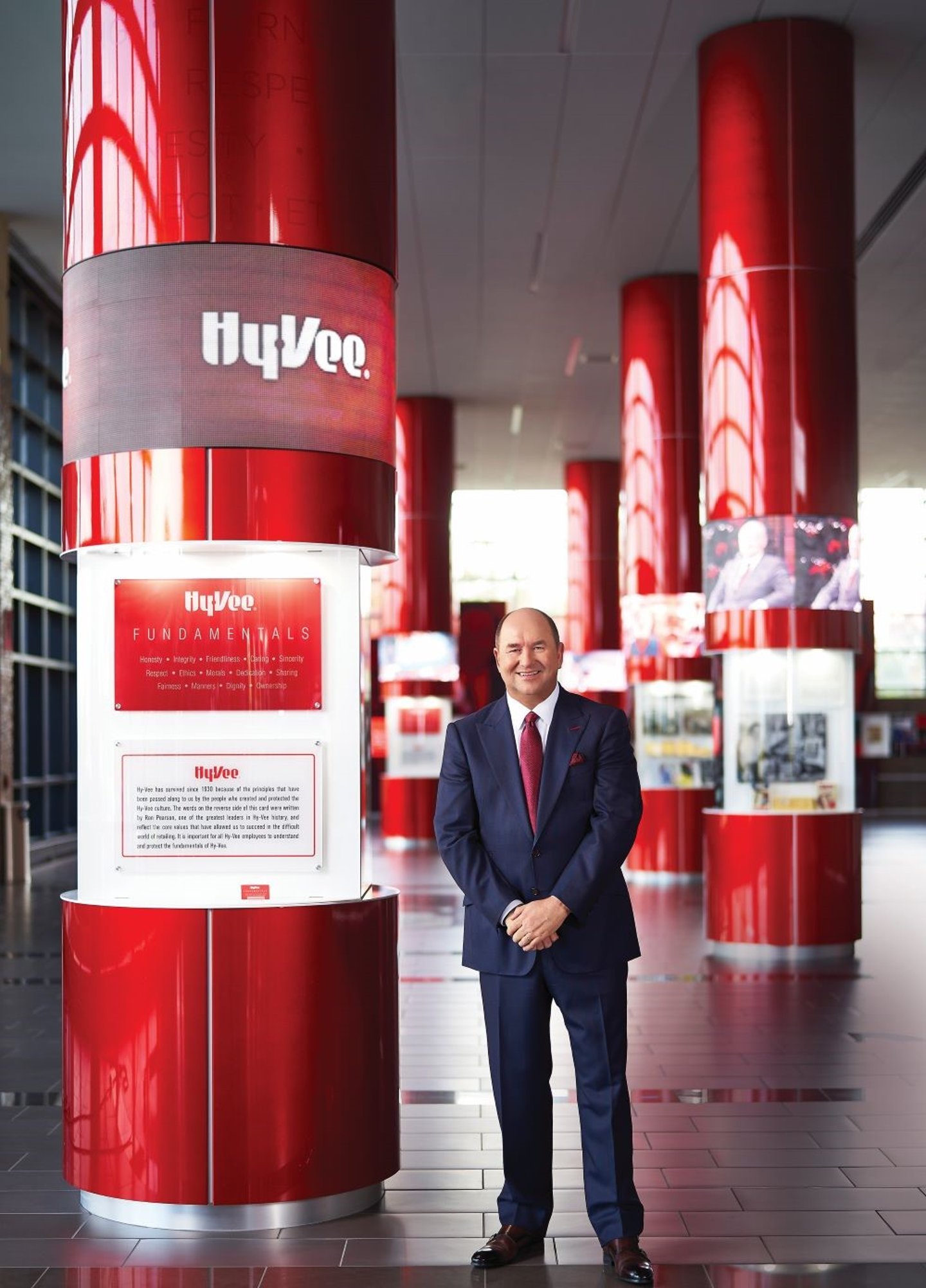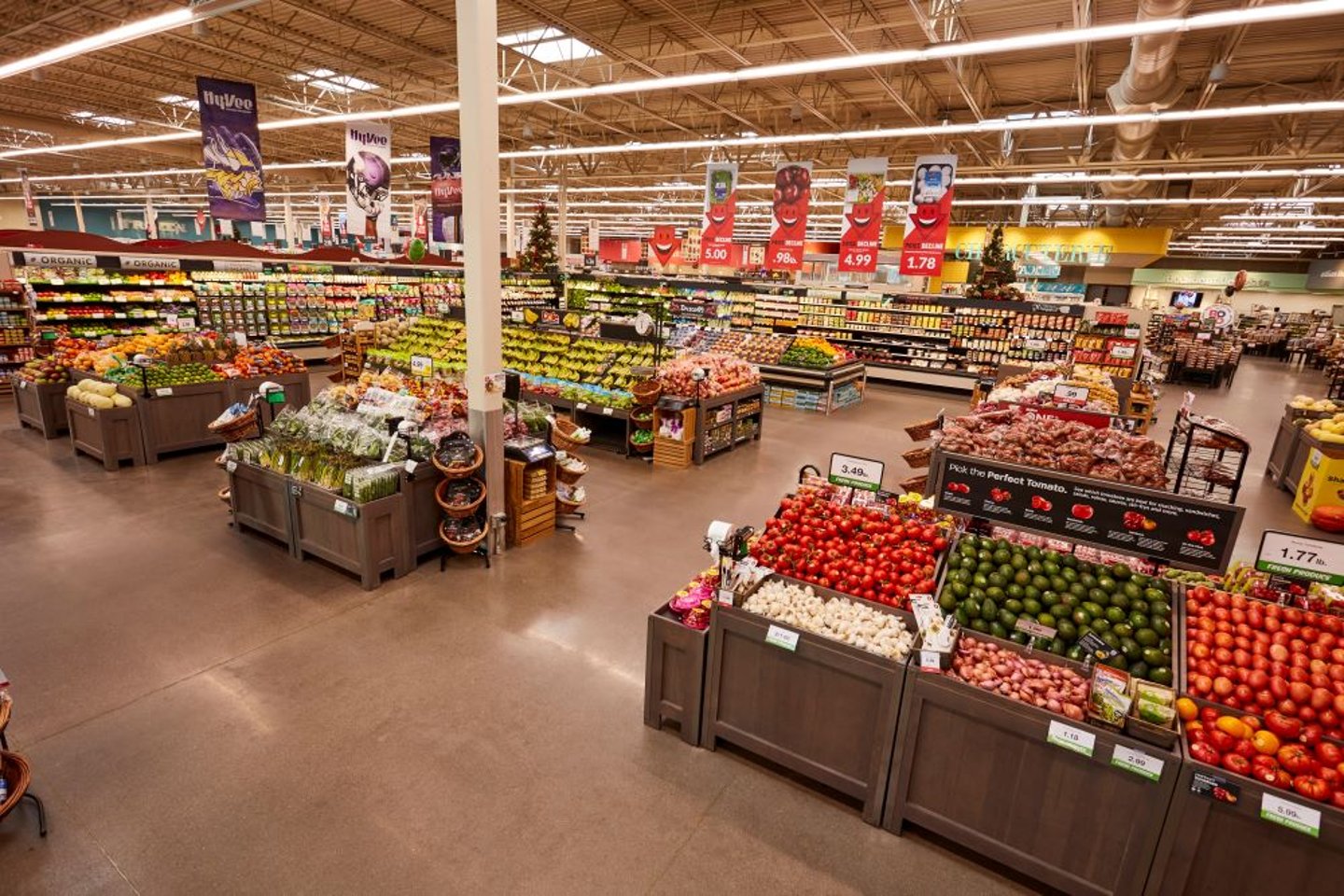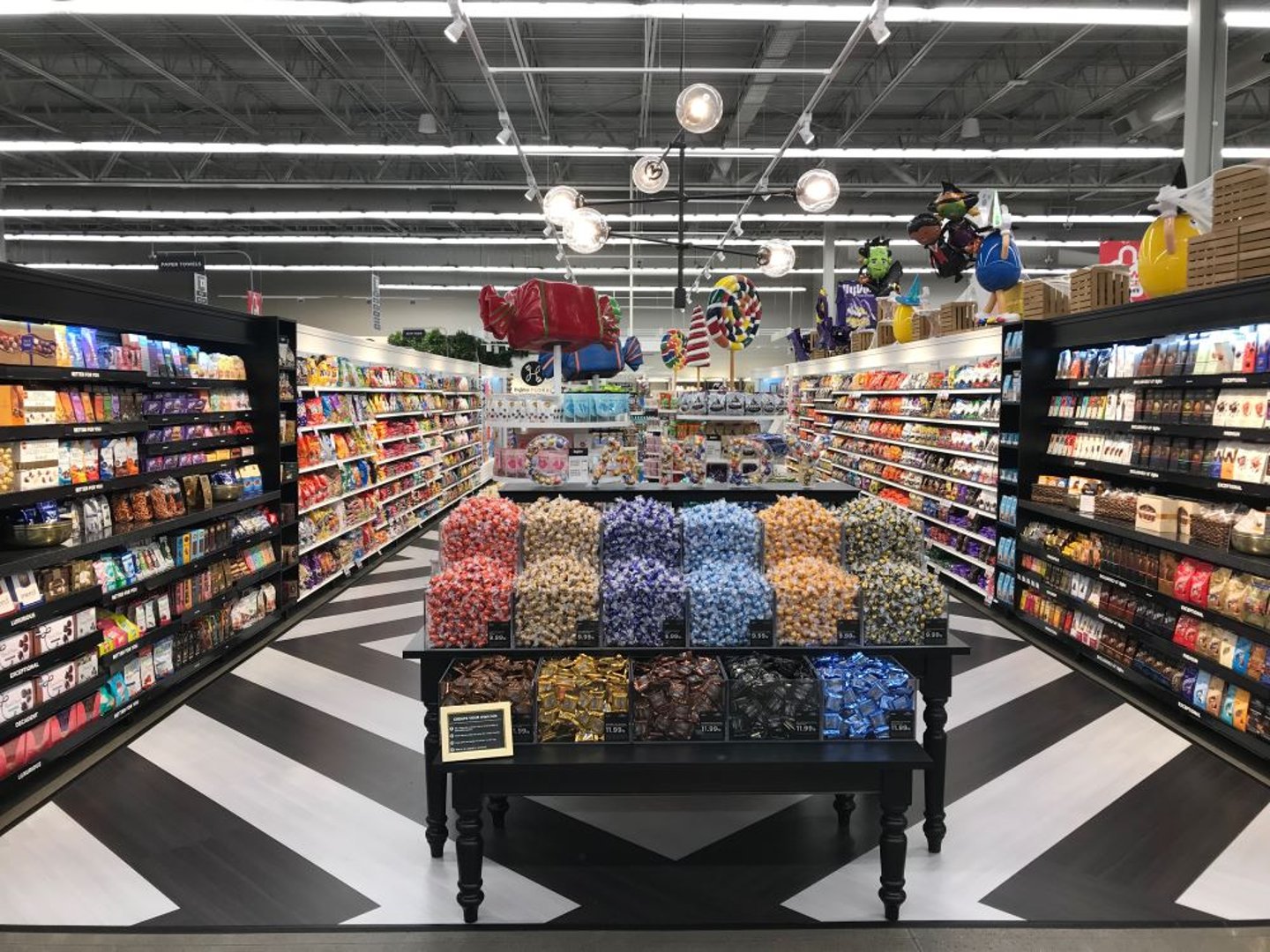How Hy-Vee Plans to Grow
Hy-Vee is on the brink of major expansion. The West Des Moines, Iowa-based grocery store chain, which operates more than 275 stores across eight Midwestern states and has sales of $11 billion annually, is emerging from the uncertainties of the COVID-19 pandemic in a stronger place than ever.
“This year is the biggest capital budget that we’ve ever had, by a long shot,” asserts Chairman of the Board, CEO and President Randy Edeker, who didn’t disclose the actual amount. “We have a new format that we’re building called Dollar Fresh, where we’re focusing on building those. We have a dozen of those built. We’ve kind of just done it quietly.”
For 2021, the company has 14 Dollar Fresh stores — its answer to deep discounters like Aldi — which measure around 30,000 square feet and provide a high-quality product assortment at low prices in smaller communities, including a full selection of groceries, a fresh baked goods, a dollar section, a Wall of Value and ready-to-eat meals, in its budget this year, as well as 12 Hy-Vee stores and 11 small-format Fast & Fresh convenience stores, which Edeker refers to as “our meal store.”
All told, Hy-Vee has 40 new retail units in the pipeline this year. It’s also planning a state-of-the-art warehouse in the Des Moines metro area. “We have a company we call Lomar, which is gourmet specially imported foods,” explains Edeker, “and so we’re building a brand-new automated facility to expand it. And then we’ll also pull off some of the slower movers from our other DCs once it’s up and going. … So yeah, budget-wise, there’s a lot happening.”
To execute the company’s most ambitious growth strategy in years, Edeker is viewing Hy-Vee’s opportunities with a new mindset influenced by the pandemic and his company’s response to it.
As Hy-Vee looks to execute this strategy, however, it does so against a backdrop of increased competition from familiar retailers and emerging threats. Hy-Vee has long held its own against Walmart and the onslaught of supercenters, and the same is true of Batavia, Ill.-based Aldi US, which honed its operating model in Iowa in the 1970s. More recently, Hy-Vee has faced increased competition from Minneapolis-based Target and one of the nation’s top c-store foodservice chains, Ankeny, Iowa-based Casey’s, in addition to Goodlettsville, Tenn.-based Dollar General, which recently revealed plans for a fresh food distribution center in Blair, Neb., and Amazon, which is working on various new fulfilment centers in Hy-Vee’s trading area.
“From a competitive standpoint today, we’re competing with Target, Walmart [and] Amazon in a way that the world is so totally changed that it really makes it just a different landscape to compete with,” notes Edeker.
'Acceleration on Steroids’
Edeker isn’t a man given to overstatement, so his description of how overwhelmed company officials and associates felt when initially responding to the pandemic back in March 2020 is all the more striking.
According to Edeker, “it was like drinking from a fire hose. You’re just trying to gather information from the CDC, from the government resources, health and human services, and local officials, and just take everything that we knew at that moment and then start to adapt to protect both our customers and our employees as best as we could.”
As well as closing down in-store foodservice sections and bulk sections, the company moved to install plexiglass barriers at checkstands, supply shoppers and associates with hand sanitizer, instituted rigorous cleaning procedures, limited the number of people allowed to enter a store, purchased cart sanitizers, and ramped up its existing e-commerce program, Aisles Online.
E-commerce had, of course, been gathering pace for several years, but “COVID really put that acceleration on steroids,” quips Edeker.
“I think once the pandemic hit, it became such an enormous part of our business overnight,” he adds. “One of the things that we did is with just this monumental increase in e-commerce was we built pickup stations in the parking lots of 150 of our largest stores. We actually bought 150 shipping containers ... because we needed an overnight solution to be able to do e-commerce at the next level. And now we’re building pickup stations in all of those 150 stores. We actually have 116 being [constructed] this year.”
The retailer’s e-commerce expansion didn’t involve only groceries.
“We’ve launched our Mealtime app for family meals to do curbside pickup,” says Edeker. “DoorDash has been one of our biggest partners through all this, both with grocery delivery and with foodservice deliveries.”
Further, as a result of the company’s stronger focus on e-commerce delivery and pickup, Hy-Vee is hiring another 11,000 people, he adds.
Edeker believes that this massive migration to online shopping, while accelerated by the pandemic, is definitely here to stay.
“Digital effectiveness has been key,” he points out, “and most [of these] things won’t go away [after the pandemic]. I think we have created habits for a lifetime now that are going to continue on. I’m sure they will evolve. There’ll be some new players, I’m sure, that come into some of these spaces. But your digital business today is a mainstay, and one that you’re going to keep investing [in,] and [that] will continue to evolve how we do business moving forward.”
Beyond online shopping itself, “store design is changing because of e-commerce,” adds Edeker. “We’re changing our customer services, departments are drive-up, centers for e-commerce are changing those. How we structure the back rooms [is] changing because of the e-commerce selection processes. We’re working to bring our digital experience into the store and really recreate that. ...We’re [also] hiring 11,000 people right now because of the influx of e-commerce and delivery, and how it works. “
Other technological advances are likewise transforming the supermarket, he posits: “Self-check is changing the front end; scan-and-go technology, we’re testing [at] one of our stores coming up.”
Overall, Ederker estimates that the pandemic has “moved us forward probably five years in strategy” with regard to the adoption of technology and other groundbreaking changes in the shopping experience.
Communication Counts
In addition to its outward-facing operations and practices, however, one key change that Hy-Vee made was to its internal communications.
“The pandemic really caused us — me — to soul search,” explains Edeker. “You know, I thought that I was a good communicator as a CEO ... until I realized I was really bad at it and I didn’t talk to the 86,000 people of Hy-Vee every week. … One of the changes that I made instantly was I started talking to all of our store directors, store managers, every single day.’”
Facilitating that resolve to communicate better and more regularly with those on the front lines was the company’s adoption of software from San Francisco-based Retail Zipline.
Hy-Vee’s use of the communications solution “came about because I realized that as a retail grocer, we weren’t structured well to be able to speak to our people,” says Edeker. “And so honestly, Retail Zipline was just a program that we went out to find because we realized we’re not able to speak to our people in a way that we should be able to speak to our people on a daily basis. I also learned right away that video was better than voice, that if they could see me say it, our people liked it a lot better than just hearing me say it. So, in the initial days, I was leaving voice messages that were 10, 15, 20 minutes long each night, telling everybody that we’re going to be OK. And then I evolved to video on my cell phone. ... And then Zipline came along as a way that we could easily get it to everyone instantly.”
As for the effect that Retail Zipline has had on his ability to share information with associates, Edeker, who’s been CEO for 10 years, wishes “I would have had it year one. We would be such a better company if we had, because I could just tell everybody every week what’s really going on. … For the most part, we are such a better company because of how we communicate today.”
All in on Events
When asked how Hy-Vee was addressing the unusual spikes in sales seen last spring that it’s now cycling against, Edeker admits: “We try to always look a year out and start working on what we’re going to do a year out. ... And so at this point, we’ve planned lots of category sales, breakfast sales, stock-up sales, those type of things, to try and offset some of that. But in some ways, you’re just not going to offset a three-month-long snowstorm panic. You’re just not going to offset that, and it doesn’t make good business sense to try to, in some ways. So we’ve ramped up planning for event sales and those things somewhat, but I wouldn’t say that we’re going crazy trying to duplicate those dollars. I just think that’s going to kind of be impossible to do. I think if anything, [our improved] communication ... has made us a lot better merchant, because the expectations, the success stories, and those things are flowing so close to time that our retailers are able to see those things, see what others are doing, build off of them, improve what they have, and make us a better merchant.”
In fact, he adds: “That’s probably the best sales tool that’s come out of this is just that we have more of an all-in mentality on event planning and the big ideas. ... But the way our team and our retailers, cause we’re very autonomous, were able to merchandise across the whole of the company, that’s the thing that will help us the most moving into these kind of big pandemic numbers. As we have events, we’re just a lot better merchants than we were a year ago. And I think that a lot of that comes back to the communications of the expectations. We’re just a lot better at that.”
Reliable Sources
Another growth opportunity for the company came from dealing with a supply chain that “was challenged on all sides,” as Edeker puts it.
“I think that there were a lot of lessons we learned about supply chain, just in timed inventories in some categories were detrimental to not just us, but other big players around the country,” he notes. “Those are things that we really analyzed where we need to have safety stock and what we need to have on hand.”
In fact, when there was talk of a resurgence of the pandemic, Hy-vee managed to put about $40 million in safety stock inventory in preparation for such a contingency.
“We [also] became much more creative with sourcing and trying to go out and find new avenues to get product,” observes Edeker. “So I think that we’re a lot better at that. We’re way better at local sourcing, finding people that are making products right in our backyard that we need to strengthen relationships with.”
Among the relationship-based sourcing measures taken by the company was to ship in a lot of meat from a foodservice supply company that couldn’t sell to restaurants under lockdown orders.
90 Years of Success
Yet another challenge overcome was how Hy-Vee would mark its 90th anniversary, which occurred amid the pandemic. According to Edeker, what saved the day was, not surprisingly, communications technology.
Using remote technology, the company “had a 90th anniversary Best Place to Work in America giveaway,” he notes. “We did it every single week.” Gifts ranged from Spyder sweaters to a Mini Cooper that had appeared in the 2003 film version of “The Italian Job,” courtesy of one of its stars, Mark Wahlberg, whose family’s fast-casual restaurant chain, Wahlburgers, has partnered with Hy-Vee on 26 locations of the burger joint in seven Midwestern states.
The grocer ended up giving away a total of $1.5 million in gifts to employees every week throughout the month and a half of its anniversary celebration. “It’s not what we planned, but it’s what we adapted to,” says Edeker.
“We were still able to celebrate in the stores ... through signage and our ads and so forth,” he adds, “but the biggest thing with our 90th anniversary is, the people that care most about it [are] the people that work for you. And so we wanted to make sure that they celebrated.”
In terms of in-store promotions, “we’re still very promotionally focused, but we’re much more focused on internal store conditions, sales, freshness, quality. And we think that then our customers are going to continue to flow to us. We’re still heavily invested in television, [and] big event sales, driving those digitally is still an emphasis. But really, print and [those] kind of old-school promotions I think are really fading now.”
Noting that how long the changes wrought by COVID-19 will endure “depends on how much the customer has changed permanently,” Edeker ventures to predict, “I think many of the things that we’ve picked up and adapted will stay.”
Asked what he’s learned about his associates during this extraordinary time, Edeker is quick to respond.
“Our people do amazing things without being asked,” he says. “We’ve had so many stories of employees going above and beyond to do the extra things, solve the problem, get the question answered, take care of people in their town, travel. So what have I learned? Probably sometimes you get caught up in all of the business stuff. But in our case, our people just do amazing things.”
- To Be the Best
When it comes to the associate experience at West Des Moines, Iowa-based Hy-Vee Inc. Chairman of the Board, CEO and President Randy Edeker doesn’t mince words.
“I want Hy-Vee to be the best place to work in America,” he says, “and then I realized that that’s not going to just happen by saying it. We’ve got to analyze every practice that we have and become better at it. … We started tearing apart our benefits; we started looking at everything people were doing. We have a massive list of things that we have changed, benefits that we’ve added. Tuition assistance: You know, you can get $10,500 to go to school each year. We have 100 of those that we give away. Every employee can get $3,500 to go back to school every single year. We went in, we expanded part-time benefits, added part-time insurance in many areas. We expanded our 401(k) to make it richer and better. We removed insurance waiting periods.”
Another key associate benefit is in the area of discounts.
“One of the things that we added was a 10% discount for groceries for all of our employees across the board,” notes Edeker. “And I throw in a 20% discount for holidays, so like Thanksgiving, Christmas. The Super Bowl, I threw a 20% discount out for our employees.”
On Feb. 22, on the occasion of Supermarket Employee Day, the grocer offered associates 40% off on all foodservice so they could treat themselves and their families to a ready-made meal.
The company has also spent “millions and millions” of dollars on bonus pay for employees, according to Edeker, and not just during the darkest days of the pandemic.
“We’ve put in a department-head bonus structure,” he explains. “We already had a part-time bonus structure in place. My goal for our full-time people in the company is our bonus structure’s based off their results of their stores that they will all get a 10% bonus every quarter on top of their wage, on top of incentive pay.”
Further, Hy-Vee has instituted premium pay for holidays.
All of these offerings, although they predate COVID-19, have become even more important in light of it as the company continues to evolve its culture.
“That’s the thing I’ve been trying to get us to focus on, is how do we culturally shift?” muses Edeker. “I want us to be the best place to work. And so I think benefits are part of it, I think giving our employees a voice and letting them hear from us. So it goes back to communication. I think all those things will stay in place because they were happening not because of the pandemic; they were happening because we’ve chosen to change those things anyway.”
On the contentious subject of raising the federal minimum wage, he observes: “My hope personally is that everybody can make $15 an hour. I mean, who doesn’t want that, right? But we have to be able to afford it, and it has to be able to work into the system. There’s just [the] sheer economics of it that when you increase costs in the grocery business with very slim margins, then cost gets passed off. That’s just the reality and economics of retail. And so, yeah, I want everybody to have everything they want and to be taken care of. … I hope that we can pay everybody $15 an hour. We just have to figure out economically how we’re going to do that. And then I think for cities to step in and just mandate it to one retail sector and not to another — I just don’t think that’s the role of government to pick winners and losers.








